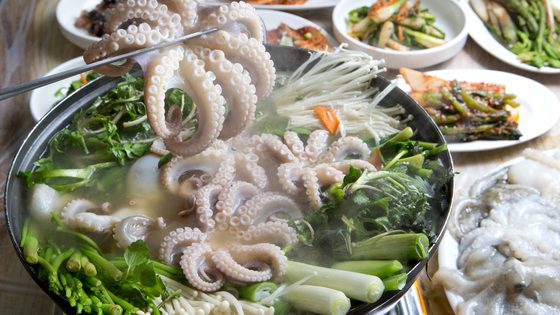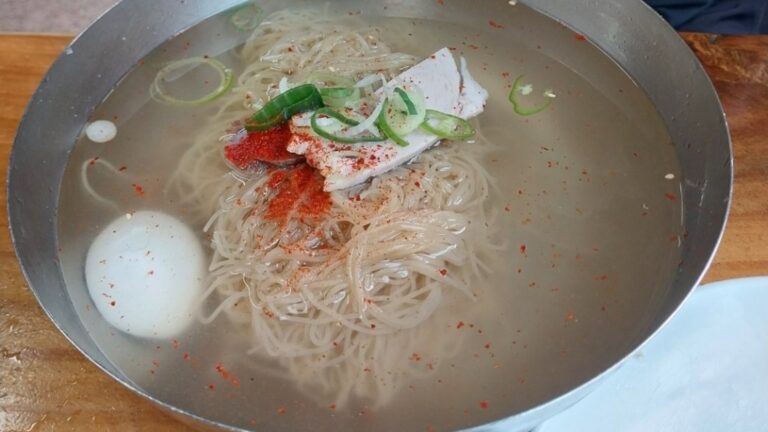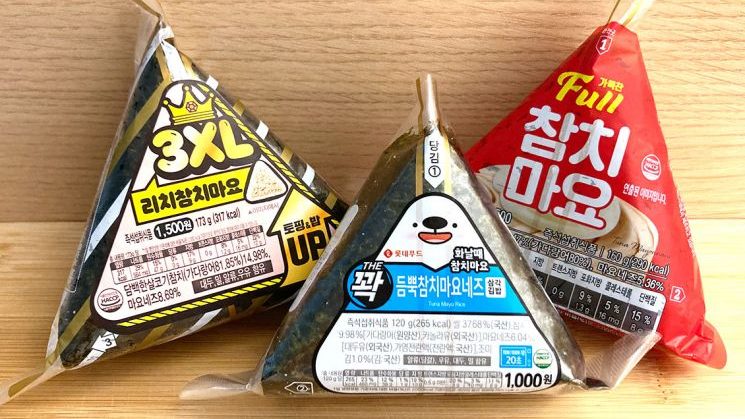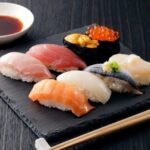Korean Octopus Dishes
When thinking of Korea, many people might first imagine bulgogi or kimchi, but Korean seafood cuisine is also highly developed. Among them, three types of octopus — nakji (live octopus), mun-eo (octopus), and jjukkumi (baby octopus) — are especially popular, each with its own unique characteristics and cooking methods.
In this article, we’ll take a detailed look at these representative Korean octopus dishes, covering preparation methods, seasonal availability, common places to enjoy them, and differences from Japanese cuisine.
1. 산낙지 (Live Octopus / サンナクチ) – A Harmony of Chewy Texture and Rich Umami
Preparation Methods:
- Tangtangi (탕탕이 / タンタンイ): The octopus is finely chopped and served with sesame oil, salt, and sesame seeds. The suction cups still move, providing a unique and fresh texture.
- Nakji Horong Gui (낙지호롱구이 / ナクチホロン焼き): Small octopuses are skewered and grilled with sweet and spicy sauce. Crispy on the outside, chewy on the inside.
- Yeonpotang (연포탕 / ヨンポタン): Whole octopus simmered in a clear broth. Clean flavor, great for hangover recovery.

Season:
Peak season is October to February (autumn to winter). Cold-water octopus is firmer, chewier, and sweeter.
Where to Try:
- Seoul: Noryangjin Fish Market, Gwangjang Market
- Busan: Jagalchi Market
You can choose your cooking style and have it prepared on the spot.
Difference from Japan:
Eating live octopus is rare in Japan. The experience of eating moving suction cups is unique to Korea and leaves a strong impression on tourists.
2. 문어 (Octopus / ムノ) – Simple but Deeply Flavored Boiled Octopus
Preparation Methods:
- Usually boiled and sliced, eaten with soy sauce or spicy vinegar-chili paste (cho-gochujang).
- Popular for celebrations like ancestral rites or birthdays.
- Variations include octopus bibimbap and octopus ramen.
Season:
Peak season is December to April (winter to spring). Cold-water octopus has firmer flesh and more pronounced umami.
Where to Try:
- Jeollanam-do: Wando and Yeosu — famous octopus regions with many specialized restaurants.
- Seoul: Traditional markets like Mangwon Market.
Difference from Japan:
- In Japan, octopus is mainly used for takoyaki, vinegared salads, or simmered dishes.
- In Korea, it’s commonly boiled and eaten simply with dipping sauces, with a preference for firmer, chewier texture.
3. 쭈꾸미 (Jjukkumi / Baby Octopus) – Rich Flavor of Egg-Filled Spring Jjukkumi

Preparation Methods:
- Most famous as spicy stir-fried jjukkumi (jjukkumi bokkeum) with sweet and spicy gochujang sauce, often eaten with rice or wrapped in lettuce.
- Can also be enjoyed as teppan grill, shabu-shabu, or hot pot.
Season:
Peak season is March to May (spring). Spring jjukkumi is full of eggs, giving a rich, savory flavor in every bite. Seasonal jjukkumi festivals are held in various regions.
Where to Try:
- Seoul: Sindang-dong and Hongdae — areas with popular jjukkumi restaurants often drawing long lines.
- Gyeonggi-do: Oido — a production area, especially busy with tourists in spring.
Difference from Japan:
- In Japan, small octopus is mainly used for simmered dishes or fried items.
- The Korean style of spicy stir-fry with sweet and hot sauce is rare in Japan and increasingly popular among Japanese tourists.
Summary: Cultural Differences in Octopus Cuisine Between Korea and Japan
Korean octopus dishes emphasize freshness, spiciness, and texture, and even simple cooking methods bring out unique flavors and character.
- 산낙지 (Live Octopus): Enjoyed in various ways while still alive, offering a chewy and fresh experience.
- 문어 (Octopus): Boiled octopus with deep, rich flavor.
- 쭈꾸미 (Jjukkumi): Small, egg-filled spring octopus, stir-fried spicy and savory.
Korean octopus dishes, enjoyed in styles different from Japan, are a must-try delicacy during your trip. Experiencing these culinary differences allows you to taste a new side of Korea while immersing yourself in its unique food culture.
Table of Contents









